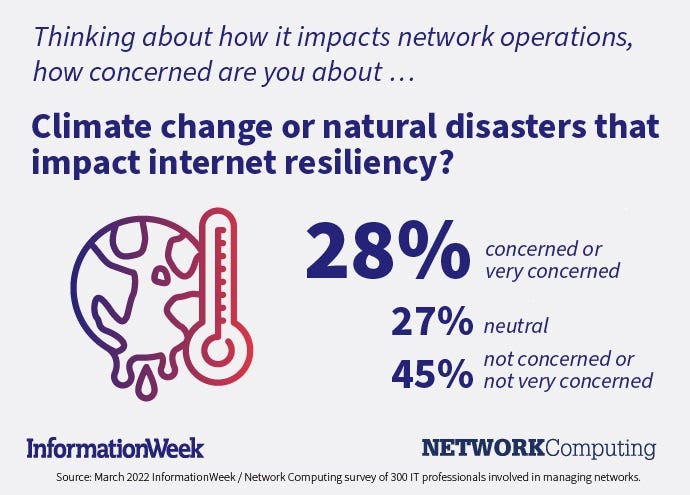As climate change accelerates, and extreme events occur more frequently -- from hurricanes and floods to soaring temperatures and water shortages -- resiliency concerns are growing.

Buckling roads and severely overheated people weren’t the only casualties resulting from the epic heat wave that struck the UK and the rest of Europe in July of this year. At least two data centers, operated by Google and Oracle, went offline as the thermometer hit an all-time high of 104.4 degrees Fahrenheit.
For now, these failures are relatively isolated incidences. Today’s data centers are built for extreme resilience and most of them can withstand harsh conditions reasonably well. However, as climate change accelerates, and extreme events occur more frequently -- from hurricanes and floods to soaring temperatures and water shortages -- resiliency concerns are growing.
“We hear much more about what data center operators are doing to help mitigate climate change rather than what they are doing to deal with the risk,” states Ron Vokoun, director of Critical Facilities for OAC, a design and construction management firm that specializes in building data centers. Yet things are changing. “People are realizing that 500-year storms now occur annually.”
Fixing things won’t be easy, says Paul Barford, a professor of computer science at the University of Wisconsin, Madison. “There has not been enough time spent thinking and studying the long-term effects of climate change on clouds and network resiliency. The impact of climate change and the threats that it could unleash are beyond our planning horizon.”
Storm Clouds Gather
At the center of everything is an inconvenient truth: The Internet wasn’t built to endure climate change. “There is a heavy focus on protecting property, physical assets, and data, but resilience is a far more complicated issue that ripples into the energy grid and many other areas,” says David Theodore, co-founder of Climate Resilient Internet, a firm promoting industry standards and certifications.
To be sure, the risk of social and economic disruption is growing as the Internet and digital technologies become more deeply intertwined into the fabric of modern life. Financial systems, commerce, transportation networks, medicine and many other fields now rely on 24x7 online and cloud access. The direct cost of an outage is about $17,000 per minute, according to Ponemon Institute.
Although modern data centers are built with resiliency and redundancy in mind -- backup generators, uninterruptable power supply (UPS) units, server clusters, separate utility feeds and colocation frameworks are a standard part of the design and architecture of these facilities -- they are not isolated islands that are impervious to outside forces.
Already, outages are already becoming longer and more expensive due to bad weather and the overall impact of climate change. As conditions deteriorate further and severe weather events become more common, these facilities are threatened on several fronts, including power, networking infrastructure, and internal resilience. The extreme heatwave in the UK that led to data center disruption is simply the tip of the climate change iceberg. “There are many external factors that can undermine the resilience of network infrastructure, which in turn impacts clouds,” Theodore says.
More than 4 in 10 outages are related to disruptions in power. Even with two or more persistent utility connections, problems can arise during a hurricane or flood. With generators and backups, a data center might be equipped to run for several hours -- and because cloud providers collocate facilities one facility can take over if another goes down. But at some point, the clock runs out if multiple locations are affected. “In an extreme event it could take days or weeks to repair critical infrastructure,” Theodore notes.
An Eye on Critical Infrastructure
The grid isn’t the only problem, however. Uptime Institute found that about 14% of outages are due to networking issues, though climate change will undoubtedly push this number up. Theodore argues that there is little, if any, accountability among infrastructure and telecom providers. It’s difficult to know when a service fails and how widespread the impact is during an outage. This lack of transparency poses a threat. For instance, in May 2021, a technical problem at a relatively unknown Internet services firm, Fastly, resulted in a global disruption of Internet services.
Long-term events like sea level rise will also have a profound impact on data centers and networking infrastructure. Many cities, facilities, and infrastructure lie on flood plains and in coastal areas that will be severely impacted by climate change. Barford, who has studied the topic, identified more than 200 data centers and more than 2,400 miles of fiber conduits that will likely be damaged by water over the next century. Repairing this infrastructure could take years.
At the other end of the climate change spectrum are problems associated with drought. Not only could this lead to an uptick in highly destructive wildfires that directly threaten facilities, but it could also undermine data center operations. Water, of course, is an essential cooling element for these facilities. Uptime Institute found that 51% of data center facilities currently do not track water usage.
Reining In Climate Chaos
Engineering our way out of this problem won’t be easy or simple. Unless major changes take place that result in radical carbon reduction, climate-related data center and Internet connectivity problems will only grow worse.
As Vokoun puts it: “Dealing with climate change risk isn’t as sexy as fighting climate change itself.” The cost issues are particularly nettlesome, he notes. “People don’t like spending money to guard against something that might happen. Constructing a data center to deal with an EF5 tornado is much more expensive than simply building to code. Where do you draw the line?”
Barford believes it’s important to continue pushing the boundaries on data center resiliency -- but also think more about where facilities are located and what climate impacts may occur in 10, 20 or even 30 years. “What may seem like a good location and a stable environment now may not be in the future,” he warns.
There’s also a need to upgrade the grid, implement microgrids that operate autonomously, and explore ways to upgrade networks for greater resiliency, Barford says. “Most conduit used for the Internet is buried only about three feet underground. There’s a significant risk resulting from severe storms and flooding.”
Theodore says that it’s vital to rethink the way that critical Internet infrastructure is currently designed. This includes relying only on fiber to connect backbones, data centers and most major infrastructure. Hurricanes and other major storms have already knocked the Internet offline for days and weeks in places like New York City, Houston, Texas and Miami, Florida.
At least part of the solution, Theodore says, is to repurpose high-end microwave technology that was used decades ago. “The point isn�’t to replace fiber, which remains the best way to deliver high bandwidth for the Internet. It’s to eliminate a single point of failure and provide a way to communicate—even if it’s a suboptimal level—during a disruption,” he says. “This approach can serve as a lifeboat until critical infrastructure is restored.”
Unfortunately, climate change-related problems aren’t going away anytime soon -- and the risks to data centers and critical networking infrastructure will continue to grow. “The most important thing,” Barford says, “is that we need to act immediately and urgently on both climate change and improving resilience. We cannot continually operate in a reactive mode that scrambles to fix problems. We cannot wait for things to reach a state of emergency.”
What to Read Next:
Special Report: How Fragile is the Cloud, Really?
8 Real Ways CIOs Can Drive Sustainability, Fight Climate Change
Lessons Learned from Recent Major Outages
Emerging Tech to Help Guard Against the Malevolence of Cloud Outages
Read more about:
Business Continuity/Disaster RecoveryAbout the Author(s)
You May Also Like








